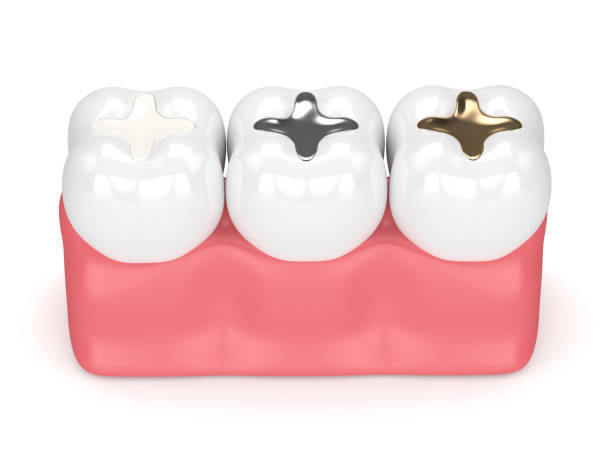Dental fillings are vital in restoring teeth damaged by cavities or decay. They repair the tooth’s structure and protect it from further damage. Several types of dental fillings are available, and understanding their features, benefits, risks, and procedures can help you choose the right option for your oral health needs.
Types of Dental Fillings
There are typically five types of dental fillings, which are outlined below:
1. Amalgam Fillings
Amalgam fillings, also known as silver fillings, are made from a mix of mercury, silver, tin, and copper. They are highly durable and can last 10–15 years, making them ideal for molars that endure heavy chewing. However, their metallic color makes them less aesthetic, and they may expand or contract with temperature changes, potentially causing cracks.
2. Composite Fillings
Composite fillings are tooth-colored and blend seamlessly with your natural teeth, making them a popular choice for visible areas. They bond directly to the tooth structure, providing added strength. While they offer excellent aesthetics, composite fillings typically last 5–7 years and are more expensive than amalgam.
3. Ceramic Fillings
Made from porcelain, ceramic fillings are a durable and natural-looking option. They resist staining and can last over 15 years with proper care. However, they are more expensive than composite and amalgam fillings and may be prone to chipping.
4. Gold Fillings
Gold fillings are crafted from a gold alloy, offering unmatched durability and longevity, often lasting 15–20 years or more. They are biocompatible, reducing the risk of allergic reactions. The downside is their high cost and noticeable appearance due to their gold color
5. Glass Ionomer Fillings
Glass ionomer fillings are a mix of acrylic and glass, commonly used for children’s teeth or cavities near the gumline. They release fluoride to help prevent further decay and are quick to apply. However, they are less durable and not as aesthetically pleasing as other materials.
Protect Your Smile – Book Your Appointment Today!Step-by-Step Guide to the Dental Filling Procedure

Getting a dental filling treatment involves several steps:
- Examination and Diagnosis: Your dentist examines the affected tooth and may take X-rays to determine the extent of the decay.
- Preparation: The decayed portion of the tooth is removed, and the area is cleaned thoroughly.
- Filling Placement: The chosen filling material is applied, shaped, and hardened using a special light or bonding process.
- Finishing Touches: The filling is polished to ensure a smooth surface and proper bite alignment.
Risks and Benefits of Dental Fillings
Dental fillings restore the functionality and appearance of your teeth while preventing further decay.
Benefits:
- Strengthen and protect damaged teeth.
- Improve aesthetics with options like composite and ceramic fillings.
- Prevent further decay and tooth loss.
Risks:
- Temporary sensitivity to hot or cold foods.
- Rare allergic reactions to certain materials, such as metals in the amalgam.
- Fillings may wear down or crack over time, requiring replacement.
FAQs: Types of Dental Fillings
Conclusion
At Night and Day Emergency Dentist, we provide expert care for all types of dental fillings. Our experienced team evaluates your dental needs and helps you select the best filling material for your situation.
Whether you’re dealing with an emergency or need a routine filling, we are available 24/7 to ensure your smile stays healthy and bright. Contact us today to book an appointment and experience exceptional dental care at your convenience!




